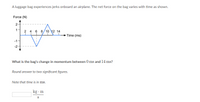Question

Transcribed Image Text:A luggage bag experiences jerks onboard an airplane. The net force on the bag varies with time as shown.
Force (N)
2
1.
2 4 6 8/10 12 14
- Time (ms)
-1
-2
What is the bag's change in momentum between 0 ms and 14 ms?
Round answer to two significant figures.
Note that time is in ms.
kg · m
Expert Solution
This question has been solved!
Explore an expertly crafted, step-by-step solution for a thorough understanding of key concepts.
This is a popular solution
Trending nowThis is a popular solution!
Step by stepSolved in 2 steps with 2 images

Knowledge Booster
Similar questions
- Wile E Coyote and Road Runner, with masses of 12.5 kg and 0.3 kg, are at having fun at the ice rink. a) Wile E Coyote moves towards Road Runner with a speed of 3.4 m/s while Road Runner is static at the center of the rink. What is the combined momentum of the two? b) They collide and stick together. What is their velocity after the collision? c) From rest, Wile E Coyote and Road Runner push off against each other and glide to opposite sides of the rink. Wile E Coyote reaches the edge, 10 m away from the original position, in 100 s. How long does it take Road Runner to travel 42 m in the opposite direction?arrow_forwardCould someone explain finding the fraction of momentum and kinetic energy lost please? The mass of cart A is 0.508 kg and the mass of cart B is 1.011 kg.arrow_forwardA 650.0-kg car makes a 90° turn. Its speed before the turn is 23.0 m/s and after the turn it is 27.6 m/s. Calculate the magnitude of the change in the car's momentum.arrow_forward
- A 950 kg car travels from 40 m/s to 31 m/s. What is the initial momentum? * -8,550 kg.m/s 29,450 kg.m/s 38,000 kg.m/s 67,450 kg.m/sarrow_forwardA rubber ball with a mass of 0.190 kg is dropped from rest. From what height was the ball dropped, if the magnitude of the ball's momentum is 0.790 kg · m/sjust before it lands on the ground?marrow_forwardThe force on an object, m, is given by: F = 30t² where F is in Newton and t in seconds. Determine the change in momentum between t = 1.0 s to t = 3.0 s. 140 kg m/s 400 kg m/s 360 kg m/s 340 kg m/sarrow_forward
- A green car with mass 1200 kg is travelling east at 40 m/s. Simultaneously, a yellow car with mass 1500 kg is travelling north at 30 m/s. They collide in a perfectly inelastic collision, such that there is no rotation. a. During the collision, which car experiences the greater force? b. What is the momentum of each car before the collision? c. What is the magnitude of the momentum of the two combined cars after the collision? d. What is the speed (magnitude) of the two cars after the collision? e. What is the direction of the motion of the cars after the collison?arrow_forward2. A 5.0-kg puppy running at 2.0 m/s picks up a 1.0-kg stick that is sitting on the ground. What is the momentum of the puppy and the stick after the puppy picks up the stick? Conceptual Physics Reading and Study Workbook Uarrow_forwardFor each of these collisions, can we see that momentum is conserved? Show why or why not, based on your data.arrow_forward
- E6.) A ball experiences a change in momentum of 24 kg-m/s.a. What is the impulse acting on the ball?b. If the time of interaction is 0.15 s, what is the magnitude of the average force acting on the ball? Answer with the correct formula.arrow_forwardA pitcher throws a baseball of mass m = 0.150m=0.150 kg with a velocity of 43.7 m/s. The momentum of the baseball is a numerical answer below. Accepted formats are numbers or "e" based scientific notation e.g. 0.23, -2, 1e6, 5.23e-8 ..... k x xg /sarrow_forwardThe graph shows the force acting on an object with a mass as a function of time. For the time interval from 0 to 8 seconds, the total change in the object's momentum (in kg.m/s) is: Force (N) Time (s) 6. -7 O a. -14 O b. -14 O C. -16 O d.-10 00arrow_forward
arrow_back_ios
SEE MORE QUESTIONS
arrow_forward_ios